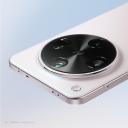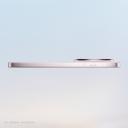
-
The first phone images and full size samples
https://drive.google.com/drive/folders/133rmbcyOP4EaS6h0E4Un_WKyRiZC7IJ6?usp=sharing
Source Weibo.
-
In the march 2025 update we received Android Auto for the Oppo Find X7 Ultra. In this moment I see no reason to dismiss the Chinese ROM, even if the phone it's not launched globally. But, I have a strong feeling, Oppo will pleasantly surprise us, internationally with the Find X8 Ultra. :)
-
Rumored specs:
6.82” AMOLED 120Hz LTPO FLAT display
Snapdragon Elite 2 processor
50MP LYT-900 (1-inch, f/1.8, 23mm)
50MP JN5 Ultra Wide (Samsung JN5)
50MP LYT-700 (3x Zoom) Periscope Telephoto (f/2.1, 70mm)
50MP LYT-600 (6x Zoom) Periscope Telephoto (f/3.1, 135mm)
Multicultural sensor
32MP front
Action button
6000mAh + 100W wired & 50W wireless
ColorOS 15 | Android 15
IP69

 photo_2025-03-22_14-09-49.jpg1280 x 768 - 61K
photo_2025-03-22_14-09-49.jpg1280 x 768 - 61K
 Oppo Find X8 Ultra gray.jpg514 x 999 - 110K
Oppo Find X8 Ultra gray.jpg514 x 999 - 110K -
Specifications:
https://wondamobile.com/products/oppo-find-x8-ultra-5g-dual-sim?_pos=3&_sid=34cab1c9b&_ss=r

 Oppo Find X8 Ultra 5G Dual SIM at Wonda Mobile.jpg1234 x 2491 - 447K
Oppo Find X8 Ultra 5G Dual SIM at Wonda Mobile.jpg1234 x 2491 - 447K -
Direct comparison between Oppo Find X8 Ultra and Xiaomi 15 Ultra, with the same subject under the same circumstances:
https://drive.google.com/drive/folders/1Sy07iMgwNJdRF4hTtAsJFLLjijR7KGQ_?usp=sharing
-
Official announcement:
First camera zoom tests:
https://www.gsmarena.com/oppo_find_x8_ultra_in_for_review-news-67333.php
-
More full size sample images, including portraits and zoom tests at all focal lengths:
Comparison between Oppo Find X8 Ultra and Find X7 Ultra:
-
GSMarena review:
https://www.gsmarena.com/oppo_find_x8_ultra-review-2822p5.php
-
Image Quality Analysis of the Oppo Find X8 Ultra
The analysis is based on a thorough examination of photos and videos available on GSMArena: https://www.gsmarena.com/oppo_find_x8_ultra-review-2822p5.php.
Photo Quality and Resolution
• Default Settings and Available Resolutions:
• The Oppo Find X8 Ultra uses computational photography by default, combining multiple frames (stacking) on each camera to achieve higher resolution.
• Users can export images at 12.5 MP (resized for maximum clarity), 26 MP, or 50 MP.
• Resolution Differences:
• The 26 MP and 50 MP options offer visibly higher resolution compared to 12.5 MP, although the 12.5 MP setting is nearly perfect in terms of clarity.
• Recommendation: It’s worth shooting at 26 MP consistently for the best balance of detail and clarity.
• The 50 MP mode performs very well in certain scenarios but depends on how steady the phone is held and how much the subjects in the frame move. Motion can introduce artifacts.
https://drive.google.com/file/d/1bike7hesLCEqYVs5T3MjrPa2OV4_nVeh/view?usp=drive_link
Sensor Performance
• Night Photos:
• All cameras produce clear images in low-light conditions.
• However, the computational algorithms need further refinement: strange artifacts appear around moving cars and their headlights (e.g., streaks or halos).
• 3x Telephoto Camera (70 mm equivalent):
• This camera exhibits unusual artifacts, such as halos with streaks around specular LED lights (e.g., streetlights or car headlights). These artifacts are also noticeable in night videos.
• The other sensors do not show these issues in video mode.
• 6x Telephoto Camera (135 mm equivalent):
• There is a slight blooming effect (a diffuse halo) around bright lights, particularly those tending toward white (this is probably a side effect of the W light path lens structure of the 135mm LYT 600 camera module: https://www.oppo.com/content/dam/oppo_com/oppo/product-asset-library/find-x/cn-find-x8-series/find-x8-ultra/assets/images-light-2-bg-1-98.jpg.webp).
• The effect is more pronounced at 50 MP resolution or with higher digital zoom levels.
Ultrawide Camera Performance (Samsung JN5)
• Comparison with Find X7 Ultra:
• The ultrawide sensor, Samsung JN5 (1/2.75 inch), is nearly twice as small as the Sony LYT-600 (1/2 inch) used in the Find X7 Ultra.
• Thanks to advanced computational algorithms and processing, the JN5 produces visibly better images than its larger predecessor, both in good light and low-light conditions, as well as in video mode.
Video Quality
• 4K Resolution:
• 4K videos are smooth and high-quality at all focal lengths.
• In low-light conditions (night), the camera tends to use a 2x crop from the 70 mm sensor instead of the 135 mm sensor when light levels drop significantly.
• Frame Rates:
• All cameras support video recording at 30 fps and 60 fps.
• 4K recording at 120 fps is available only on the 23 mm (main) and 70 mm (3x telephoto) cameras.
• The phone also supports Full HD at 240 fps, but it’s unclear on how many cameras this is available (further testing required).
Tonal Range, Colors, and Dynamic Range
• The tonality, colors, and white balance (WB) are very good across all focal lengths.
• The larger Sony sensors (LYT-900, LYT-700, LYT-600) offer better dynamic range (DR) and more detail compared to the ultrawide camera (Samsung JN5).
Macro Functionality
• 3x Telephoto Camera (70 mm):
• The macro function has been moved to the 70 mm sensor, allowing focusing as close as 10 cm from the lens.
• Macro shots can be taken at 50 MP resolution, providing additional magnification through cropping if desired.
• 6x Telephoto Camera (135 mm):
• This camera lacks macro functionality and cannot focus at close distances.
Additional Observations and Future Testing
• Master Mode:
• JPG and RAW images at 12.5 MP are single-shot captures.
• Computational RAW and JPG at 50 MP are also available, but their performance requires further testing. • Motion Priority:
• The observations above apply to standard photo and video modes.
• Algorithms may change when prioritizing motion, which requires further testing. • General Note:
• The analysis focuses solely on photo and video modes.
Howdy, Stranger!
It looks like you're new here. If you want to get involved, click one of these buttons!
Categories
- Topics List23,981
- Blog5,725
- General and News1,354
- Hacks and Patches1,153
- ↳ Top Settings33
- ↳ Beginners255
- ↳ Archives402
- ↳ Hacks News and Development56
- Cameras2,362
- ↳ Panasonic991
- ↳ Canon118
- ↳ Sony156
- ↳ Nikon96
- ↳ Pentax and Samsung70
- ↳ Olympus and Fujifilm100
- ↳ Compacts and Camcorders300
- ↳ Smartphones for video97
- ↳ Pro Video Cameras191
- ↳ BlackMagic and other raw cameras116
- Skill1,961
- ↳ Business and distribution66
- ↳ Preparation, scripts and legal38
- ↳ Art149
- ↳ Import, Convert, Exporting291
- ↳ Editors191
- ↳ Effects and stunts115
- ↳ Color grading197
- ↳ Sound and Music280
- ↳ Lighting96
- ↳ Software and storage tips267
- Gear5,414
- ↳ Filters, Adapters, Matte boxes344
- ↳ Lenses1,579
- ↳ Follow focus and gears93
- ↳ Sound498
- ↳ Lighting gear314
- ↳ Camera movement230
- ↳ Gimbals and copters302
- ↳ Rigs and related stuff272
- ↳ Power solutions83
- ↳ Monitors and viewfinders339
- ↳ Tripods and fluid heads139
- ↳ Storage286
- ↳ Computers and studio gear560
- ↳ VR and 3D248
- Showcase1,859
- Marketplace2,834
- Offtopic1,319














